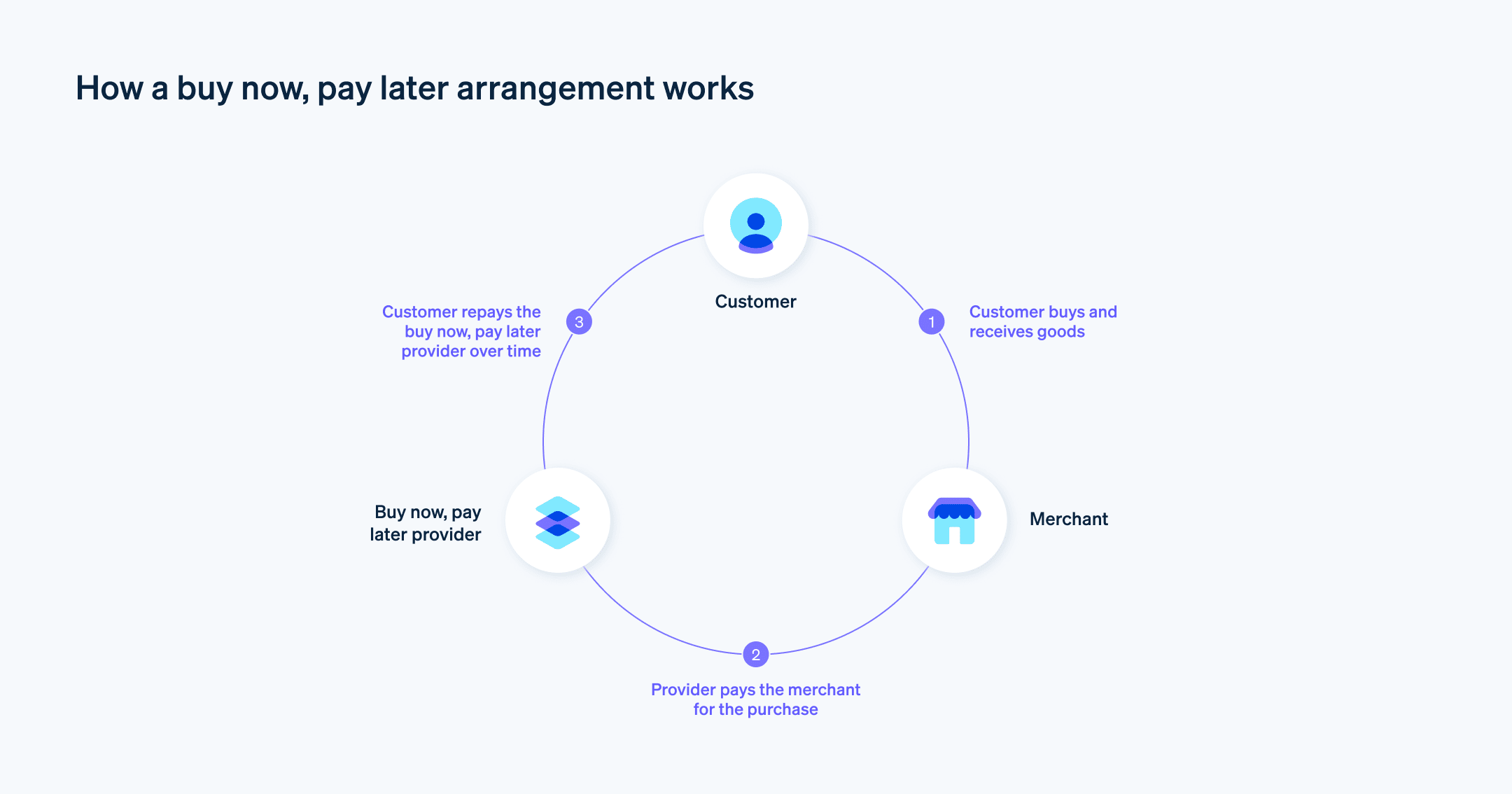分期付款将商品或服务的成本分摊到一段时间内。通过这种方法,欠款总额被分成较小的金额,由买方按设定的时间表支付,而不是一次性支付。这种支付方式 通常用于大额采购,使个人和企业可以根据财务规划和现金管理目标更好地控制付款。付款计划由卖方和买方在购买时商定,间隔时间不定。这种付款计划可能包括利息和其他费用,具体取决于贷款人或企业设定的条款。
在本文中,我们将介绍企业需要了解的有关分期付款的信息:分期付款的定义及其运作方式、它们如何与其他客户付款趋势互动,以及如何制定深思熟虑的策略来实施和使用分期付款以满足您的特定业务需求。
目录
- 分期付款和先买后付 (BNPL) 是一回事吗?
- 分期付款如何运作?
- 企业何时应提供分期付款?
- 分期付款的优势和挑战
- 热门分期付款服务概览
- 分期付款如何融入您的业务
- 企业分期付款最佳实践
- Stripe 能提供什么帮助
分期付款和先买后付 (BNPL) 是一回事吗?
分期付款允许客户通过多次付款来支付产品或服务的总金额,付款时间在购买时安排,通常包括首期付款。这种方法以延期付款为前提,让客户立即获得产品或服务,同时在未来多个日期分期付款。这种财务灵活性也是先买后付 (BNPL) 模式的核心,它是分期付款概念的延伸,但更依赖于延期付款方面。BNPL 通常不涉及预付费用,旨在快速、轻松地集成到电商平台。随着时间的推移,客户按预先确定的、通常是免息的分期付款方式履行付款义务。这不仅简化了客户的个人财务管理,还使他们能够在没有直接经济压力的情况下进行购物。
BNPL 对那些既重视即时满足又注重预算的客户尤其具有吸引力。而对于企业来说,将 BNPL 作为一种支付方式,除了能提高销售量和客户忠诚度外,还能扩大企业的影响力。2022 年,全球 BNPL 市场估计超过 62 亿美元。关键在于事先签订明确的协议,不收取隐性费用,从而满足客户对金融参与透明度和控制权的渴望。
分期付款和 BNPL 不仅仅是一种金融机制,也是一种战略,可以通过灵活的金融解决方案帮助企业发展、开拓新的细分市场并建立客户忠诚度。

分期付款如何运作?
分期付款将交易总成本分解为更易于管理的分期付款。这种方法对企业和客户都有利,因为如果只选择一次性付款,他们可能无法获得商品或服务。其工作原理如下:
分步细分
就条款达成共识
分期付款的基础是买卖双方就付款结构达成一致。这包括总购买价格、付款时间表以及任何利息或费用。这一阶段涉及透明度和为双方设定期望值。首付款
作为对购买的承诺,买方通常会支付首付款。这种首付会减少分期支付的总余额,并可能影响买方的分期付款金额和利息。分期付款
支付首付款后,买方要遵守定期付款计划。每次分期付款都会减少剩余的贷款余额,而在支付利息时,会将利息分摊到各次分期付款中,以确保在贷款期结束时支付全部借款成本。利息和额外费用
利息补偿卖方延迟全额付款,并反映资金的时间价值。处理 过程中可能会收取额外费用,或作为延迟付款的罚金,以鼓励及时遵守付款时间表。完成付款
当买方完成所有分期付款并履行其财务义务时,该周期结束。资产或服务随之全部付清,所有权全部转移或服务协议最终确定。遵守合同义务
在整个分期付款过程中,双方都必须遵守约定的条款。不遵守可能会导致经济处罚或法律后果。
企业何时应提供分期付款?
当企业认识到他们销售的产品与客户的购买行为相匹配时,就应该考虑分期付款。如果他们的产品或服务标价很高,客户可能无法一次性付清,那么分期付款可以让客户更容易接受。
采用分期付款协议作为付款选项的决定可能会受到多种因素的影响,包括:
商业模式和定价结构
对于拥有高价值物品或服务(例如电子产品、家具或教育课程)的企业,分期付款可以减轻客户的直接经济负担,从而使其更容易接受。客户群
如果企业的目标市场包括年轻人群或静态购买力较弱的人群,分期付款可以符合他们的财务习惯,而这种习惯通常更倾向于灵活性。电商和在线影响力
由于数字结账流程可以无缝集成分期付款和/或 BNPL 选项,从而在客户做出决定时满足客户需求,因此线上企业 尤其能从这种方法中获益。市场竞争力
在市场饱和且竞争激烈的行业中,提供分期付款可以使企业脱颖而出,并提供可能影响客户选择的竞争优势。订阅服务
对于以订阅模式 经营的企业,尤其是前期成本较高的企业,允许分期付款支付初始注册费可以降低进入门槛,增加订阅量。奢侈品和服务
销售高档产品的公司通常会发现,分期付款可以将客户群扩大到有能力全额支付的客户之外,从而开拓更广阔的市场。
实施分期付款的理想时机需要考虑以下几个因素:
产品发布
在推出高价值的新产品时,分期付款方案可以吸引那些有兴趣但可能对成本犹豫不决的早期用户。市场拓展
当企业希望进入更广阔的市场,尤其是那些经济背景各异的市场时,分期付款对处于购买决策边缘的客户来说是一个决定性因素。季节性高峰
在传统的高消费时期,如节假日,分期付款可以鼓励客户进行大额消费,而不会造成直接的经济损失。消费者需求
关注消费趋势。对 BNPL 服务的需求激增表明,客户正在寻求更大的灵活性来管理他们的支出。如果您的竞争对手提供 BNPL,那么您也应该考虑这样做,以保持相关性和竞争力。销售停滞不前或下滑
如果企业发现销售停滞或下降,尤其是价格较高的商品,分期付款可以重新激发潜在买方的兴趣,提高他们的支付能力。
归根结底,就是要了解客户的需求,并根据销售内容和销售对象来确定对企业最有意义的方式。在客户积极寻求 BNPL 选择的时候提供分期付款,既能提高客户满意度,又能促进业务增长。但是,如果分期付款与您的特定业务不相关 — 比如,如果您卖的是 5 美元的蜡烛 — 那么就可能不值得您付出运营上的努力。
分期付款的优势和挑战
对于考虑分期付款的企业来说,必须权衡增加客户便利性和潜力增收 与更复杂的财务跟踪和风险管理需求之间的关系。谨慎实施 — 或许从试点计划或第三方合作 开始 — 可以试水,并就分期付款如何融入现有商业模式提供见解。
在考虑各种选择时,以下是一些可能的优势和风险,值得注意:
优势
增加销售量
通过打破成本壁垒,企业为客户敞开了大门,否则他们可能会放弃高价购买。由于客户更愿意立即购买,而不是分期付款,因此可以选择分期付款,从而提高平均订单价值和购买频率。更广泛的市场覆盖面
分期付款方案不仅适用于那些无力全额支付的客户,它还能吸引那些喜欢管理每月预算的精明消费者。这可以将企业的触角延伸到那些注重财务灵活性的市场。根据 Juniper Research 的预测,到 2027 年,全球 BNPL 用户数量 将超过 9 亿。改善客户的现金流管理
客户可以根据自己的收入流向安排付款流出,从而在不影响财务稳定性的情况下更容易获得高价值物品。这也可能会提高客户的忠诚度,因为客户会感谢我们的通融。
挑战
热门分期付款服务概览
分期付款服务商的队伍在不断壮大,每家公司都有自己的特色,以迎合客户和企业体验的不同方面。以下是该领域的一些领先企业:
Klarna
Klarna 有一系列灵活的付款选项,其中一些取决于所在地,包括立即付款、货到付款和分期付款方案。其模式设计尽可能简单明了,注重流畅的用户体验。对客户而言,Klarna 的市场吸引力在于其用户友好型应用,以及在遵守付款期限的前提下,可以推迟全额付款而无需支付利息或费用。Klarna 对重视透明和可管理支付方式 的人群的吸引力使企业受益匪浅。Afterpay/Clearpay
Afterpay 在英国也被称为 Clearpay,它提供将一笔交易分成四笔等额分期付款的选项,分期付款时间为六周,还提供其他更长期的融资选项(视地点而定)。该服务以无息方式吸引客户,前提是按时付款。对于零售商来说,Afterpay 提供了一个机会,通过提供一种与他们的生活方式和消费习惯相结合的分期付款解决方案,吸引那些可能对大额消费犹豫不决的客户。Affirm
Affirm 的与众不同之处在于提供较长期的融资选择,期限从一个月到三年不等。其利率根据信用、融资选项和购买金额而有所不同,但都会事先向客户说明。这种透明度以及较长付款期的选择,使 Affirm 对计划大额采购的客户很有吸引力。从企业的角度来看,Affirm 可以通过为客户提供灵活和预先确定的付款时间表,帮助完成平均订单价值较高的销售。
这些服务正在重塑客户的购买方式,在欲望和实惠之间架起一座桥梁。当企业整合这些服务时,他们不仅为客户提供价值,还能使用这些平台获得更多销售额并提升购物体验。每项服务的功能(从付款时间表到利率)都应与企业的产品和客户群相契合,以找到最合适的方案。
分期付款如何融入您的业务
将分期付款融入业务运营可以提升服务质量,支持客户的金融偏好 — 只要您以正确的方式处理。下面介绍如何有条不紊地开展这项工作:
选择服务商
根据企业规模、客户群和产品种类,选择合适的支付服务商。Stripe 等提供商拥有全面的解决方案,可满足各种商业模式的需要,并支持分期付款。一定要寻找具有简单明了的应用程序编程接口 (API) 和可靠支持的服务商,以简化集成过程。服务商还应该为您的客户创造从结账到最终分期付款的简单体验。实施技术集成
与您的 IT 团队或服务商的技术支持合作,将分期付款选项集成到您现有的支付网关 中。集成过程包括设置分期付款方式、更新结账界面以包含此选项,以及确保您的会计系统可以记录分期付款。做好操作方面的考虑
培训团队管理分期付款流程,包括客户查询和付款跟踪。这包括了解分期付款的细微差别 — 从处理最初的客户查询到管理逾期付款或未付款。拥有一支信息灵通的团队可为客户提供帮助,从而为客户带来更好的体验,增加对企业的信任。与客户沟通
向客户明确传达新的付款方式,概述其好处和适用的任何条款。透明度非常重要;您的营销和客户服务沟通应明确说明分期付款的运作方式、涉及的任何利息或费用,以及客户在付款时间表方面的预期。保持合规性和安全性
确认分期付款系统符合金融法规,并且客户数据已得到安全处理。遵守金融法规和维护客户数据的高安全标准 不仅是一项法律义务,也是与客户建立信任的重要途径。在集成过程中,这方面应是重中之重。
通过遵循这些步骤,企业可以将分期付款以一种补充其运营、满足客户需求并遵守监管标准的方式整合起来。
企业分期付款最佳实践
将分期付款协议纳入企业的支付选项需要深思熟虑的执行。以下是确保这些协议对客户和企业都有利的最佳实践:
条款的透明度
分期付款方案的所有条件都应事先明确说明。客户需要了解付款时间表、任何利息或费用,以及如果付款延迟或错过会发生什么。这种明确性可以建立信任,防止日后产生误解。直观的流程
复杂的程序会阻碍使用,因此保持流程简单明了是关键。客户越容易设置和理解付款计划,就越有可能完成购买。客户服务
为分期付款方案提供出色的支持是必要的。客户在付款时可能会有疑问或遇到问题,快速、有用的回复可以改善他们的整体体验和对企业的印象。灵活的支付选项
灵活性可以成为竞争优势。提供不同频率和利率的分期付款方案选项,可以满足不同客户的需求。强大的基础设施
企业应确认其系统可以处理分期付款。这意味着整合正确的技术来管理和跟踪一段时间内的付款,并培训员工处理特定于分期付款的查询。法规遵从性
必须遵守与信贷和融资相关的所有金融法规。这包括公平的广告、明确的条款和条件以及有关客户数据的隐私法。财务健康检查
在实施分期付款之前,企业应评估其财务健康状况,以确保其能够承受延迟的收入流,并确保所有相关利益方了解分期付款销售将如何影响收入确认和会计核算。
通过遵守这些最佳实践,企业可以制定对双方都有利的分期付款协议,从而提高销售额和客户忠诚度,同时保持业务完整性和财务健康。
Stripe 能提供什么帮助
Stripe 为企业集成 BNPL 服务提供了全面的解决方案。以下是 Stripe 如何协助商家进行此类分期付款:
立即向企业支付
借助 Stripe 的 BNPL 服务,企业可以立即收到全额付款,而客户可以灵活地分期付款。这对销售高价值商品(客户可能无法一次性付清)的零售商以及提供价格较低产品并希望销售量较大的零售商尤其有利。结账集成
结账时的客户体验非常简单:客户选择 BNPL 选项,登录其在供应商处的账户,同意还款条款,然后返回企业网站完成交易。灵活的还款方式
Stripe 支持各种 BNPL 提供商,例如 Affirm、Afterpay/Clearpay、Klarna 和 Zip。这些服务有多种还款结构,包括免息分期付款和长期融资的可能性--适合各种购买规模。
通过整合 BNPL 选项,Stripe 可以帮助企业适应客户的偏好,从而提高转换率和客户获取率。详细了解 Stripe 如何支持 BNPL。
本文中的内容仅供一般信息和教育目的,不应被解释为法律或税务建议。Stripe 不保证或担保文章中信息的准确性、完整性、充分性或时效性。您应该寻求在您的司法管辖区获得执业许可的合格律师或会计师的建议,以就您的特定情况提供建议。